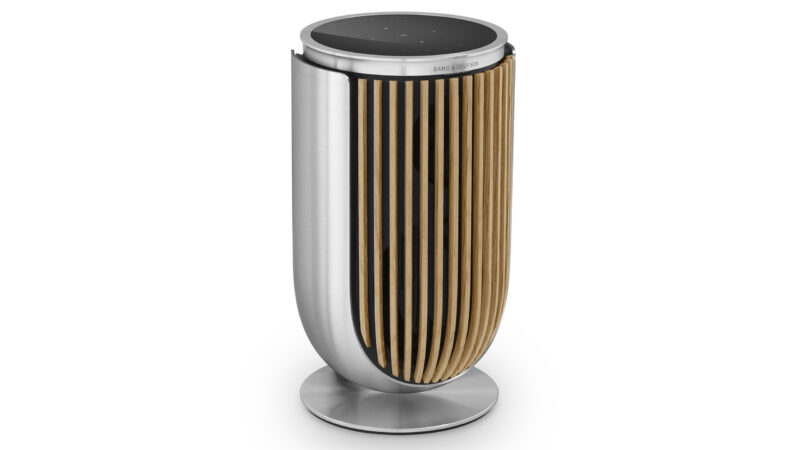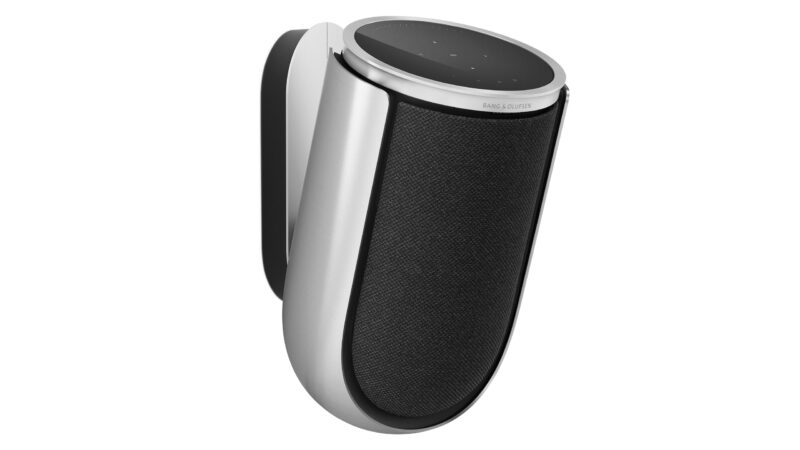Bang & Olufsen are faithful to their own recipe. Which should be seen as a good thing. Models don’t change with random fashion fads, but are continuously updated for years – or even decades.
Beolab 8, however, is brand new. So new that we are one of the first media outlets globally to have had the opportunity to test it.

Beolab 8 is the smallest model in the Beolab series, which consists of active speakers for the full-size stereo or surround system. This is in contrast to the Beosound models, which are (mostly) standalone table speakers that do not require a stereo pair.
In fact, the Beolab 8 has a leg in both camps, as one speaker can function as a table speaker in the same way as the Beosound 2 or Beosound Balance, both of which cost about the same. However, Beolab 8 is a pure mono speaker, while Beosound 2 and Beosound Balance both offer some form of stereo effect or spatial sound.
A trophy
With its cylindrical shape, rounded bottom and cabinet in gold-plated aluminium (also available in silver and black), the Beolab 8 looks like a trophy. The speaker comes with a circular base for placement on a table or sideboard. Metal discs in black, silver and gold colours are included to place on the base. Stands for floor placement and brackets for wall mounting are also available. The front grille is available in three colour variants of oak strips and fabric.
The top of the speaker is covered in black glass and the touch panel for source selection and volume appears when your hand approaches the speaker. In addition to this, Beolab 8 can of course also be controlled with the Bang & Olufsen mobile app (Android and iOS) and with Bang & Olufsen’s own remote controls (not included).
Regardless of the location, the stand must be mounted using a Y-shaped plastic bracket that snaps onto the back of the speaker. It’s stable enough, but it’s a little surprising to see such a primitive solution on a speaker that is in every other way so accomplished in its choice of materials and workmanship.
The third-generation Beosound 2 speaker looks the same, but with new software to ensure a good, long lifespan.
On the back are three RJ-45 ports, two of them for Ethernet and the third for Bang & Olufsen’s own Powerlink system. There is also a USB-C port that can be used to transfer audio, but most people will probably only use the speakers wirelessly via Wi-Fi, AirPlay 2 and Chromecast. Or, for that matter, Bluetooth with the quality limitations that come with it. Tidal Connect and Spotify Connect are also built-in.
300 watts in total
Behind the oak grille you’ll find three drivers: a five-inch woofer, a three-inch midrange and a tiny 15 mm tweeter dome tweeter. The woofer is powered by a 200 W class D amplifier, and the midrange and tweeter each have 50 W at their disposal. At least in the peaks – before the built-in sensors warn the signal processor that it’s time to turn the volume down.
The Beolab 8 is equipped with a system B&O calls Adaptive Bass Linearisation, which means that at low sound levels, the speaker has a linear frequency response down to 28 Hz. This requires a significant boost in the bass. As the volume is turned up, the bass boost is reduced so that the small bass unit is not overloaded. Bang & Olufsen states that a set of Beolab 8 can deliver a maximum sound pressure of 104 dB, but the maximum level in the bass range is only 90 dB.
Beolab 8 has so-called Beam Width Control, which means that the speaker can become more or less directional. This was a system introduced with the 25 times more expensive Beolab 90. The Beolab 90 contains 18 drivers that point in all directions. But how is this done in a relatively standard three-way speaker? According to Product Manager Casper Christensen, who is responsible for the Beolab speakers, it is done by manipulating the crossover frequency between the units, as a smaller unit has better sound dispersion at a given frequency – and vice versa. In this way, the Beolab 8 can be made more or less omnidirectional with a tap in the app.
Simple set-up
The test samples were delivered with table stands. In order to get them to a suitable height and at the same time get a wider perspective than the TV bench was capable of, they were placed on my regular speaker stands. This would probably not have been appreciated by the design department, but it worked.
The setup was exemplary easy: plug the first speaker into the mains and let the mobile app discover it. Once the speaker is on the wireless network, the speaker itself performs the automatic room correction. Both speakers were set up and connected as a stereo pair in less than 15 minutes.
Like other current Bang & Olufsen speakers, the Beolab 8 can play music via Tidal Connect and Deezer. Spotify Connect is also supported, but as Spotify still doesn’t offer hi-fi quality streaming, it is of less relevance. If the selection is not enough, you can stream wirelessly from your mobile phone with Chromecast and Apple AirPlay 2. Bluetooth is of course also supported.

The sound of the Beolab 8
It’s easy to underestimate a small speaker that resembles a floor vase, but unlike its counterparts in the same price range, the Beolab 8 is designed for stereo use.
As usual with Bang & Olufsen speakers, the overall sound is pleasant, with a tendency towards warmth. Not boomy or dark – just warm and cosy. If you prefer a different tonal balance, this can be achieved in the app.
Wide or focussed sound?
With the sound dispersion set to Narrow in the app, the Beolab 8 has a very nice stereo perspective and an equally nice depth to the soundstage. If you have to put your finger on it, you could wish that the sound came more free from the speakers.
With the spread set to Wide, the sound image is spread out. This gives a pleasant sense of spaciousness, but at the same time, the precision of the depth perspective is lost. For background music and light pop, this can be relaxing. But the speakers are much more like hi-fi in the Narrow setting.
Bang & Olufsen's latest creation, Beosound Theatre, is one of the coolest things we've seen and heard in the soundbar category. But it costs!
The volume is naturally limited by the size of the woofer and cabinet. Bang & Olufsen recommends using Beolab in rooms up to 50 square metres. In my 25 square metre living room, there was no shortage of sound pressure, although the bass in Right Hand Man from ”Hamilton” didn’t seem as powerful and the temple drums in Zhao Congs Moon Light On Spring River lacked impact.
I often use Disturbed’s cover of Sound of Silence as a stress test for speakers and amplifiers. The latter half of the track mixes full orchestra with vocals and acoustic guitar. And in the vast majority of cases, the electronics lose their breath and mix things up into a mush of sound.

But not the Beolab 8. The big dynamic fulfilment is lacking, but guitar and vocals are clear in the sound image. This is probably because the Beolab 8 is an active speaker with separate amplifiers for the three drivers. So while the woofer is fighting a good fight – and is saved by the DSP from being overdriven – the midrange and tweeter play effortlessly and cleanly.
Competition
The Beolab 8 are by far the cheapest stereo speakers from Bang & Olufsen, costing just over half the price of the Beolab 18. And they sound absolutely impeccable. But there are alternatives that provide a more nuanced sound. For example, the Dynaudio Focus 20 XD costs just a bit more. Or you can buy a good streaming amplifier like the Lyngdorf TDAI-1120 and combine it with passive compact speakers: Buchardt Audio S400 MKII, PMC Prodigy1 – the options are endless.
Conclusion
The Beolab 8 is an interesting product that appeals to both stereo lovers and those just looking for an attractive tabletop speaker. In fact, by Bang & Olufsen standards, it’s downright cheap. It plays both loud and with weight – and pleasantly at all times. Comfort is top notch – and build quality even higher. If you already have a home filled with B&O and are looking for a pair of cheap rear speakers, there’s nothing to worry about. But there’s a world outside of Struer, and you can find active wireless speakers with even better sound for the same price. Or, for that matter, buy a whole system with passive stereo speakers and a good streaming amplifier.

We think
Excellent sound. Great design and build quality. Few can match B&O in this area. Automatic room compensation. Cheapest B&O living room speakers Pricey. You can find better sound for the price.
4998 €
Specifications
- Configuration: 5.25″ woofer, 3″ midrange, 15 mm tweeter
- Amplifier: 1 x 200 W ( woofer), 1 x 50 W (midrange), 1 x 50 W (tweeter)
- Frequency range: 28-23000 (no tolerance specified)
- Max. sound pressure (per pair): 104 dB / 90 dB bass
- Connectivity: 2 x Ethernet, Powerlink (RJ45), USB-C, Wi-Fi 6, Bluetooth 5.3
- Control: iOS, Android, remote control (not included)
- Stereo pairing option: Yes
- Streaming: Spotify Connect, Tidal Connect, AirPlay 2, Chromecast, Beolink multiroom
- Audio formats: MP3, WMA, AAC, ALAC, FLAC, WAV, AIFF, OGG, HLS.
- Resolution: Up to 192 kHz / 24-bit
- Other: Active Room Correction, Adaptive Bass Linearisation, Beam Width Control
- Dimensions: 16.5 x 29.0 x 18.9 cm (WxHxD)
- Weight: 4.1kg
- Colours: Silver, black, gold (cabinet), light oak, brand oak, black oak, fabric (front)
- Web: bang-olufsen.com







